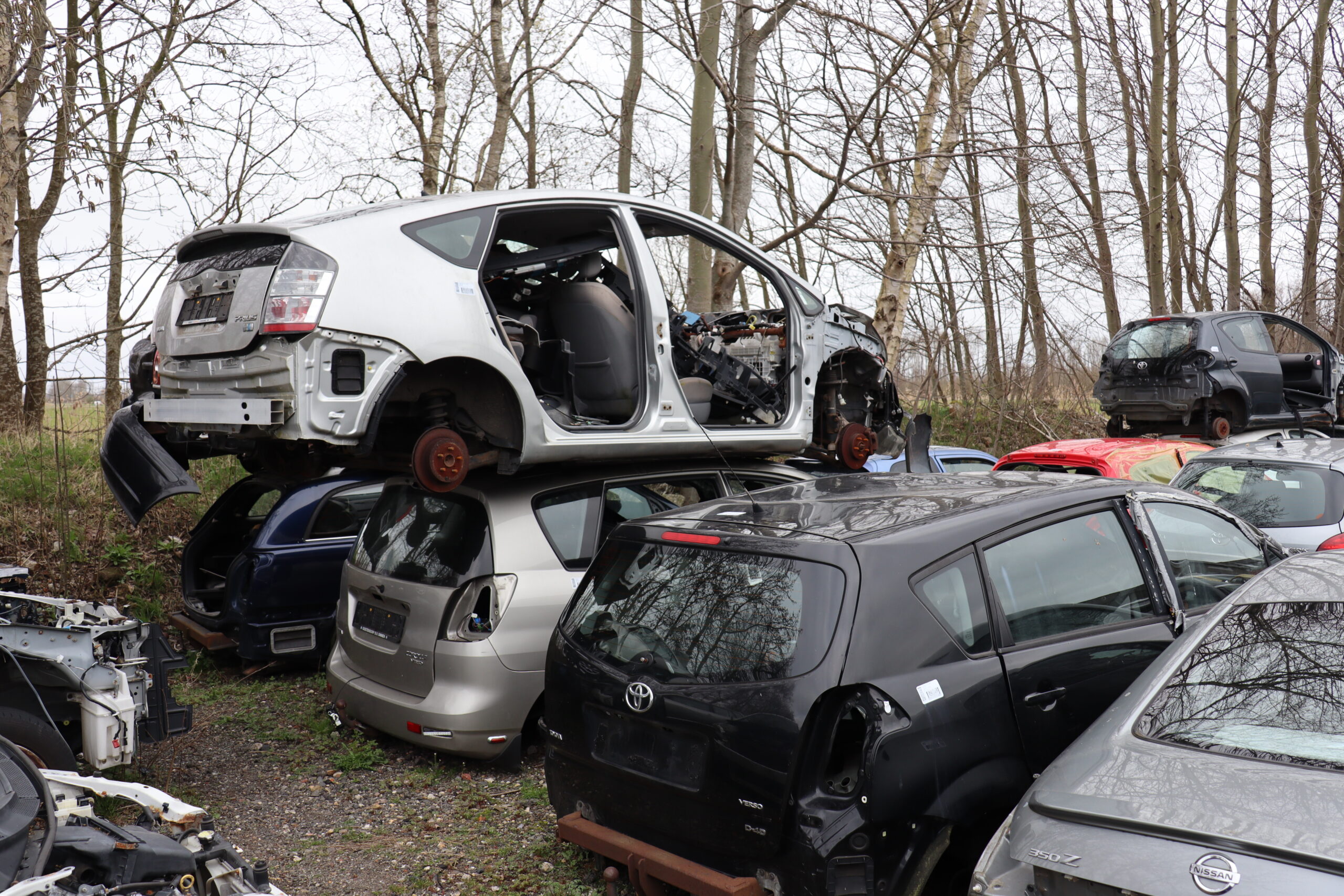Every year, end-of-life vehicles (ELVs) create a huge waste stream within the European Union. The ELV Directive was adopted in 2000 to properly manage the 7 to 8 million tonnes of waste from ELVs. At the end of 2020, this key legislation for the European car recycling industry will be reviewed. High time to take stock. What has the directive brought us? And where are we going?
Officially it is known as “Directive 2000/53/EC”, but everyone involved in the European car recycling industry knows it as the “ELV-directive”. Since 2000, it has been the directive in the field of end-of-life vehicles (ELVs). The aim of the ELV directive is to minimise the impact of ELVs on the environment and to improve the environmental performance of the economic actors in the chain. For example, the ELV Directive provides for the reduction of waste from ELVs with the high reuse, recycling and recovery targets, the depollution of liquids and specific components and the prevention of the use of certain heavy metals in new vehicles. In addition, the directive aims to ensure that well-equipped and registered facilities – ATFs in technical jargon – collect and process end-of-life vehicles. Everything is therefore about prevention, reuse and recycling.
Review
Because a lot is changing in the automotive industry in general and in the car recycling industry in particular, the ELV directive is occasionally dusted off. In 2014, a “fitness check” was carried out. At the moment, a review is even on the cards. By 31 December 2020, the current ELV regulation is to be reviewed closely. The decision to do so was taken in May last year. Then, after two years of discussion between the EU Member States and the European Parliament, the “waste package” – which includes the ELV legislation – was finally adopted. The aim: a European policy to promote the circular economy. Through a collection of ambitious measures, the re-use of products and materials in Europe must now really become everyday practice.
“We consider the ELV Directive to be one of the best examples
of the circular economy”
Successful
Since the turn of the century, the ELV Directive has changed a great deal in the car recycling industry in Europe. In particular for the better. For example, the number of ATFs (authorised treatment facilities) has increased throughout Europe and there is a substantial reduction in the use of heavy metals in new vehicles. The 85% and 95% recycling targets have also been achieved. After all, the vast majority of the total weight of all end-of-life vehicles had to be sensibly reused.
Artemis Hatzi-Hull, who is responsible for the ELV directive within the European Union, is also satisfied with the legislation and its results. “We regard the ELV Directive as one of the best examples of a circular economy. It is one of the best directives in the European Union in terms of results. So far, nearly all the goals have been achieved.” It is also, according to her, an innovative directive. “It was the first waste directive with producer responsibility for the products from the design until the waste phase, with specific targets.”
Criticism
Critical sounds are also heard. During the most recent international car recycling congress in Vienna (March 2019), leading Dutch recycling consultant Manfred Beck raised quite a few objections. As chairman of the congress, he pointed out that there are still illegal markets and exports. “There are still too many illegal companies that are not competing fairly with the authorised dismantling and processing companies.” And we need to find a solution to the fact that it is unclear where many ELVs are. Beck calls for registration and traceability.
According to research, between 3 and 4 million ELVs are disappearing on an annual basis in Europe, compared with 6 to 7 million ELVs, which are properly processed under the ELV Directive. In view of the disappearance of the ELVs, Beck considers it important that the Certificate of Destruction (CoD) be retained as proof that a vehicle has been properly processed at an authorised company. It is important that it is enforced more strictly. He believes that the European Commission should first ensure that the current legislation works, before new goals are formulated. Finally, Beck wants a level playing field in Europe. In doing so, he warns that the laws and regulations should not get out of hand. “There is a great demand for sensible legislation and regulations.”
Plan of action
On behalf of the European Commission, Artemis Hatzi-Hull is not deaf to the voices in the industry. According to the policy officer, there are many issues that are dealt with in the evaluation of the ELV Directive. She argues in favour of improved inspection of ATFs. The certificates of destruction must be issued by the ATFs and not by the collection points. She is also considering incentives for the last owners of cars to ensure that end-of-life vehicles also end up at ATFs.
Furthermore, she is in favour of reducing illegal activities and actors. More attention needs to be paid to missing vehicles and better criteria for distinguishing between used cars and ELVs. The illegal treatment of end-of-life vehicles and the illegal transport of end-of-life vehicles can thus be combated. Better registration systems in the Member States are vital and exchange of information among Member States. It helps to keep a grip on where vehicles are. Hatzi-Hull specifically mentions the improvement of the International Dismantling Information System (IDIS) as a focus of attention, as a source of information for dismantling. In addition, the data exchange about the import and export of vehicles must be different. This applies both to movements within the EU and from the EU to third world countries.
Consistency
The revision of the ELV Directive will take a closer look at the main definitions. They are different in the various directives that are important. For example, the ELV Directive, the Battery Directive and the Waste Electrical and Electronic Equipment (WEEE) Directive are more in tune with each other. The ELV directive will also need to define more clearly how to deal with electric vehicles, which in turn must be in line with the battery directive (which is also being revised).
“The ELV Directive is one of the best directives
in the European Union in terms of results.
So far, most of the goals have been achieved.”
Finally, Hatzi-Hull mentioned that the European Commission will consider the feasibility of setting targets for each material. Incidentally, this is something that interest groups are not keen on. ACEA, the association of European car manufacturers, says that a material-specific quota does not add any extra value to the ELV. Hatzi-Hull also mentioned that the revision of the ELV directive will look into how cars can be designed in a more sustainable way. In such an “eco-design”, the recycling of car parts is already being considered on the car manufacturer’s drawing board.
Focal points
The evaluation looks at the effectiveness, efficiency, relevance, coherence and EU-added value of the ELV Directive so far. Even though Hatzi-Hull states that the goals have been achieved, the question is whether this has been done cost-efficiently. The evaluation will look – of course – at how relevant the ELV directive still is.
Does it cover the current issues or amendments are needed? Finally, Hatzi-Hull indicates that the ELV Directive is also being looked at with introspection. After all, does the EU have any added value? If the Member States had taken matters into their own hands, would there have been a different outcome?
Timeline
The review of the ELV Directive is not an easy task. For example, in the third quarter of 2018 – as a kick-off – the parties involved were asked for their input to the Roadmap that was published. The response was huge, as Hatzi-Hull received feedback from no less than thirty participants. So the ELV directive really is alive! In the first part of this year, the parties involved were asked for their opinion and, in the second part of 2019, the key figures will be able to count on an extra in-depth interview. A final document will follow at the end of the year. The evaluation will be followed by an Impact Assessment, which will indicate the changes needed.
The Commission’s proposal for the review of the directive will then be sent to the European Parliament and the Council in 2020. Once the proposals have been approved, the revised ELV directive must be implemented in national legislation. This will therefore not be before 1 July 2022 at the earliest. The whole procedure is publically available at the Commission’s website.



